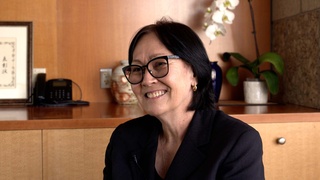Interviews
The Kids and Japanese Language (Japanese)
(Japanese) I had 4 children. Girl, boy, girl, boy in that perfect order. I was lucky. Two of them were born in Japan, and the other two were born in California.
I did want them to speak Japanese, so I wrote the Japanese phonetics and put it on the wall to teach them in the beginning. Eventually they forgot, or rather… There was a Japanese language school in Santa Maria. We took the kids there on Saturdays. But back then I was working at a tailor. The owner had moved to Los Angeles and I took over the store, which made it impossible for me to take my kids to Japanese school on Saturdays. My husband helped in the beginning, but they quit eventually. They kind of stopped speaking Japanese, so they can’t really speak.
Date: February 6, 2015
Location: California, US
Interviewer: Izumi Tanaka
Contributed by: Watase Media Arts Center, Japanese American National Museum
Explore More Videos



Feeling prejudice while looking for jobs
(1919 - 2015) Nisei who served in World War II with the 442nd Regimental Combat Team

Invited to teach at Harvard by his boss
(1919 - 2015) Nisei who served in World War II with the 442nd Regimental Combat Team

Accepted by Japanese society as I learned more Japanese (Japanese)
(b. 1979) Sansei Nikkei Brazilian who lives in Oizumi-machi in Gunma prefecture. He runs his own design studio.

The term Nikkei (Japanese)
(b. 1979) Sansei Nikkei Brazilian who lives in Oizumi-machi in Gunma prefecture. He runs his own design studio.

Mother founded Japanese language school in neighbors’ backyard
Sansei judge for the Superior Court of Los Angeles County in California

Her brother’s reasons as a No-No Boy
(b. 1923) Japanese American poet, activist

On telling his wife he had radiation sickness and his son’s cancer
(b. 1938) Japanese American. Hiroshima atomic bomb survivor

Since childhood, he has been interpreting for his father.
Professor of Law, University of Sao Paulo, Lawyer, Translator (b. 1948)

Foreign language education was severely restricted during the war
Professor of Law, University of Sao Paulo, Lawyer, Translator (b. 1948)

Impact of Coming Out on Her Family
(b. 1957) Jusice of the Supreme Court of Hawaii.
